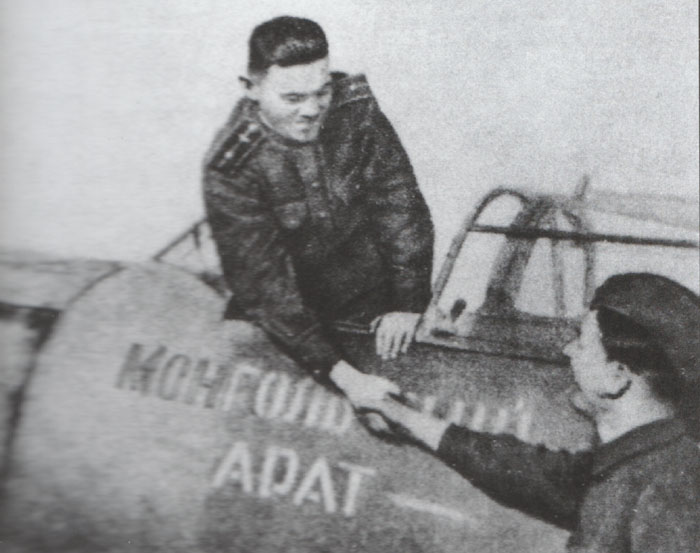
When reorganized in late 1944, the regiment received 12 La-7s 'Mongolsky arat' that were gifted by Mongolian shepherds.
All these planes were assigned to the 2nd Squadron, headed by Capt. I.T. Koshelyev.
The planes had inscriptions 'Mongolsky arat' on both sides of the fuselage.
The unit had already received and employed some La-5FN 'Mongolskiy Arat' before the reorganization of August 1944.
Image from Lavockin La-7 of Milos Vestsik, MBI
Now, we have both verbal informations, both photos of La-7s of this unit. All those don't fit particularly well, and require a difficult attempt of interpretation.
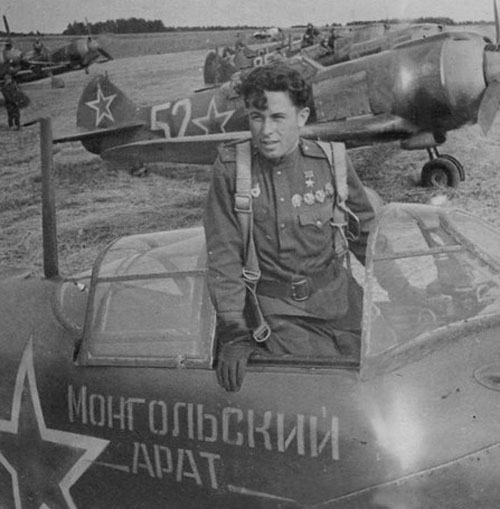
The memoirs of Kardopoltsev, veteran of 2 GiAP, say:
...“Mongolskii Arat” ... without any difference to other planes, with the exception of an insignia, it was in red or white letters. Later we painted the noses of the planes in red – it was a tradition for all the planes in our regiment, and we also made a white “cap” at the upper part of the keel...no insignias. All planes had a “Guards” symbol in the front of the plane. We did not even drew the stars for kills…
The interview doesn't say if Kardopoltsev is referring to La-5s or La-7s, and if the red or white color for the slogan 'Mongolskiy arat' appeared both on the same plane, or only one of them.
Aside, a La-5FN 'Mongolsky arat'. The description of Kardopoltsev doesn't fit here (no red noses, no guards emblem, no red or white inscription, no white cap) so it has to be referred to La-7s.
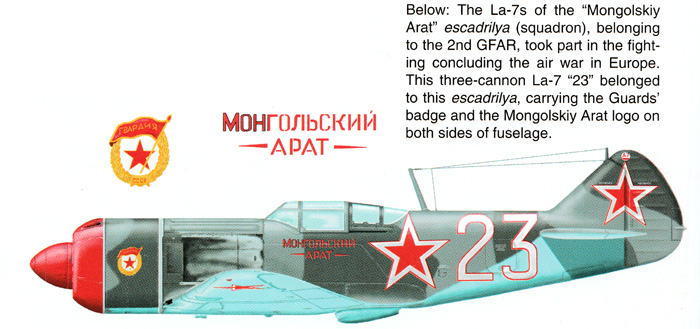
Another important reference, Lavochkin La-7 of Milos Vestsik, MBI, says:
'Prior to relocating to the airfield at the airfield of Smerdyna (beginning of January 1945) ... painted the noses of their aircraft red and applied Guards emblems to the sides of the fuselages...
The book has a profile of a 3-guns plane 23, with a red slogan, a red nose and a Guards emblem on the nose; the caption says that it was on both sides. The book doesn't show any photographical evidence of the plane; anyway the description fits enough with that of Kardopoltsev, apart for the white cap.
Here is the profile of MBI book.

Another important reference, M.Bykov, has drawn the profile aside, that is partially supported by photographic references that he has kindly provided to us.
http://warspot.ru/204-samolety-sovetskih-istrebitelnyh-aviapolkov-chast-ii
The interpretation is completely different than the profile of MBI: no Guards emblem; blue spinner and sides of the cowling, white oblique line on the tail as regimental mark.
Besides, the use of blue squadron markings doesn't fit with the memoirs of Kardopoltsev that exclude this.
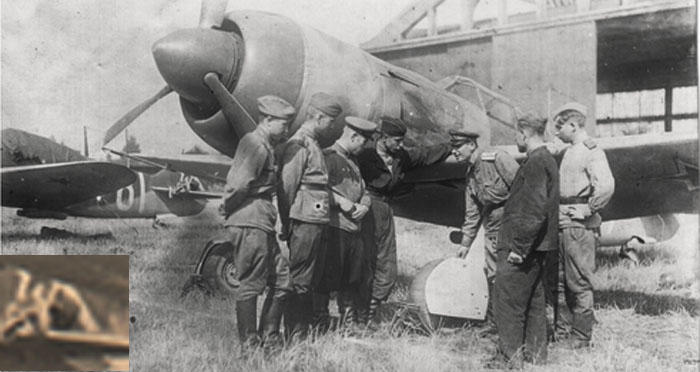
This photo shows, on the background, plane 81 of the previous profile of M.Bykov.
The white line, the number 81 and the apparent absence of any Guards emblem are confirmed by the photo, while the repainted nose was extrapolated from photos of other planes of the same unit, but the colors are subject to interpretation.
Note that the closer plane, whose number is unreadable, seems to have red nose and spinner as described by Kardopoltsev and the MBI book, but the sides of the cowling have an ordinary camouflage.
The enlarged detail shows the white line on the rudder of plane 81.
photo: courtesy of M.Bykov via PG monster
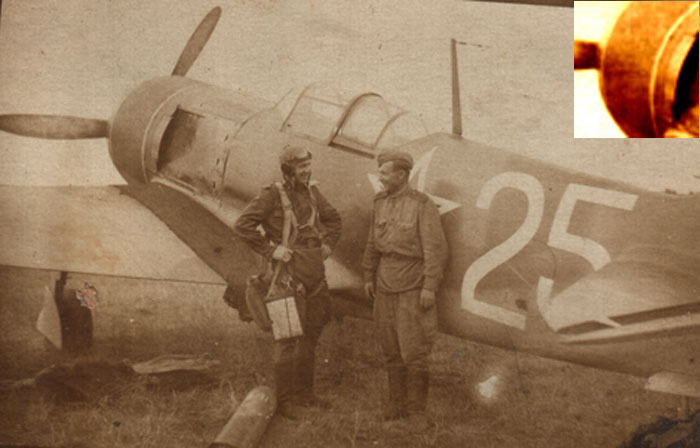
Photo of plane 25.
Unfortunately the tail isn't visible.
The cowling don't show a visible Guards emblem on it; it looks uniform and perhaps a bit darker of other parts of the plane, but the light blue ventral surfaces are clearly visible under it.
Increasing the contrast of the nose, we see a vague light blotch whose size and position could be compatible with a Guards mark, oversprayed with a dark color, probably AMT-12. Nothing decisive here.
photo: courtesy of M.Bykov via PG monster
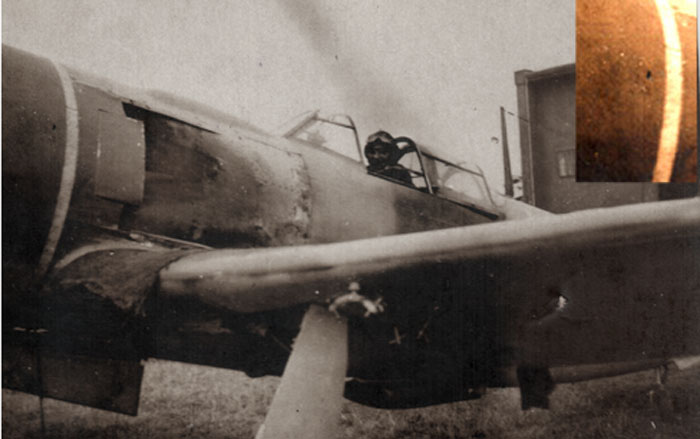
This image doesn't give informations on bort numbers or on the white line on the tail; despite this, it is interesting because it seems to show a deleted Guards marking on the cowling side. It seems also to distinguish something of the starlet, that was rotated forward.
Again, the light blue undersurfaces are visible, so it's likely that the mark was deleted by repainting all the camouflaged side of the panel with dark grey AMT-12.
photo: courtesy of M.Bykov via PG monster
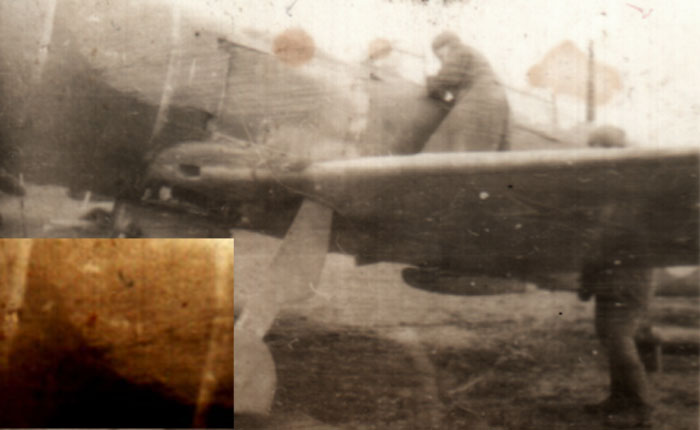
This ugly image seems to show the same thing, even more clearly. Some details as the white background of the star and a lighter circle including the leaves are recognizable.
Again, it gives the idea to be rotated counterclockwise.
photo: courtesy of M.Bykov via PG monster
On this image, we see two aces: Capt. I.S.Skrypnik and Yg. Lt. N.D. Nikitin in spring 1945.
Even on this scan from a printed photo, we can see a vague lighter circular halo.
Image from Lavockin La-7 of Milos Vestsik, MBI
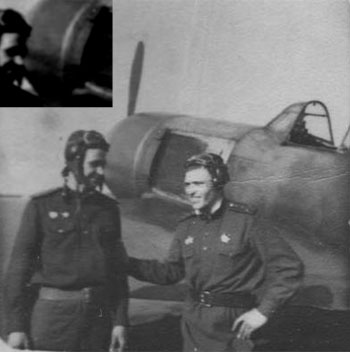
Photo of a plane of 2 giap in 1945. Pilots are Kardopoltsev and Marchenko.
We can recognize that the sides of the cowling are glossy and dark.
Again, a vague circular halo suggests the rough deletion of a Guards mark; a darker dot on its centre could correspond to the red starlet too.
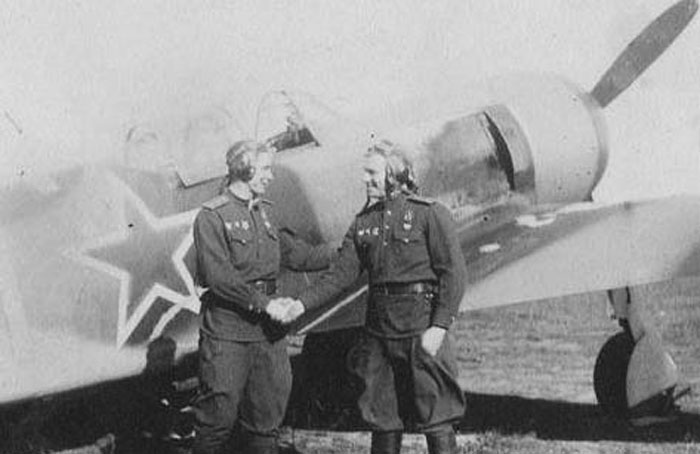
Pilots Arefyev and Kardopolzev after their first sortie over Berlin.
Note that this plane hasn't any slogan painted on, so probably it wasn't Kardopoltsev's plane that was of 2nd squadron and had the slogan 'Mongolskiy arat' on both sides.
The red cowling ring is recognizable.
The side of the cowling is painted with an uniform medium color, probably grey AMT-11 (instead of the darker AMT-12 that looks credible for the previous images); this seems to confirm that there was a Guards emblem on the right side too (as stated by the MBI book), and that was deleted.
The bort number, only vaguely visible, ends with 1. There is some possibility that this was n.81.
All these considerations seem to suggest this progression:
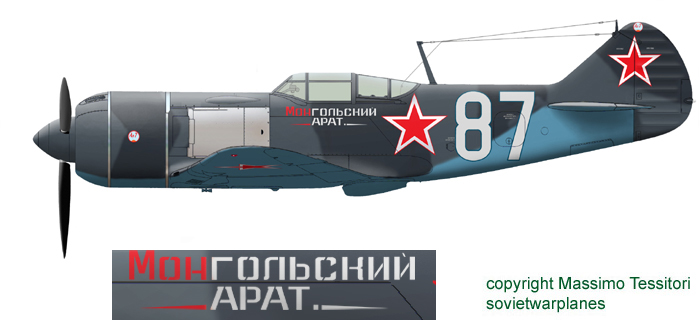
The original planes were first delivered to the unit in August 1944 without particular marks, apart for the inscriptions on the gift planes.
Plane 87 appears on a photo below, but its nose and tail aren't visible; so they are inspired to photos of other planes of the unit.
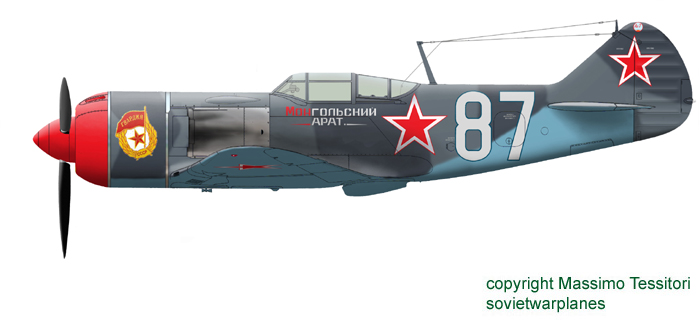
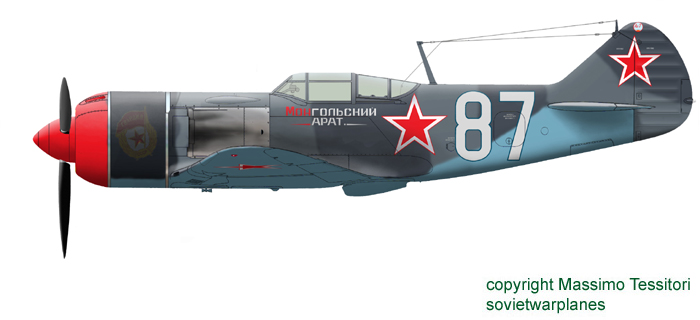
Some time later, some countermand could have arrived, and the Guards marks were deleted, repainting the cowling sides, usually with AMT-12 dark grey paint.
The new paint appeared darker and more glossy than the original weathered camouflage. The deleted emblems could be still vaguely visible through the grey layer.
On some planes, solid AMT-11 instead of 12 was utilized, obtaining an uniform light look; on other planes, the original two-greys camouflage was restored on the cowling, appearing darker and more glossy than the unrepainted and faded parts of the plane.
The planes that, for any reason, hadn't received the Guards mark featured the usual camouflage on the cowling sides, without repaintings.
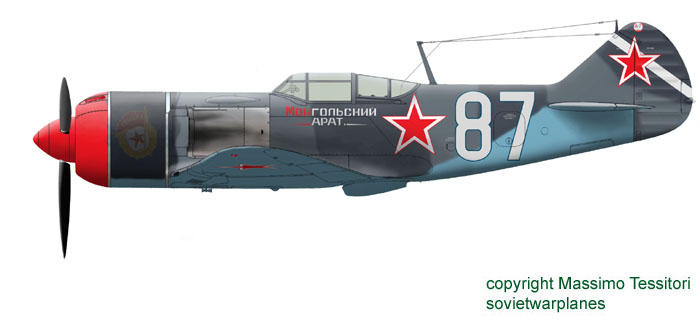
On some date still to clarify, an oblique white line (not a cap) was painted as regimental marking, perhaps not on all planes.
So the regiments making parts of the 322 iad (fighter air division) were marked in this way:
- 2 giap: one white oblique line;
- 482 iap: two white oblique lines;
- 937 iap: three white oblique lines.
http://wio.ru/simbols/iad322.htm
The photo of plane Georgievskiy Putyeyets (see at the end of the page) shows a repainted nose but not the white oblique line on the tail, so it seems that it was painted after the deletion of the Guards marks; this is determining in my attempt to reconstruct this chronology.

Here we see an inscription 'Mongolsky arat' on a La-7, that seems to suggest the use of two colors: they could be white on the dark grey bands (AMT-12), and red on the lighter grey (AMT-11).
This is compatible with the 'white and red' on the interview to Kardopoltsev, and was seen on some La-5s of Eskadrilya Valeriy Chkalov' too.
On the photo, we see tiny black outlines around the red letters, but probably the photo was retouched to put them into evidence because of their poor contrast on the AMT-11 band.
According to the memoirs of Kardopoltsev, when replacement planes were delivered to this squadron, they received the inscriptions 'Mongolskiy arat' for uniformity, even if they weren't gift planes.
Image from Lavockin La-7 of Milos Vestsik, MBI
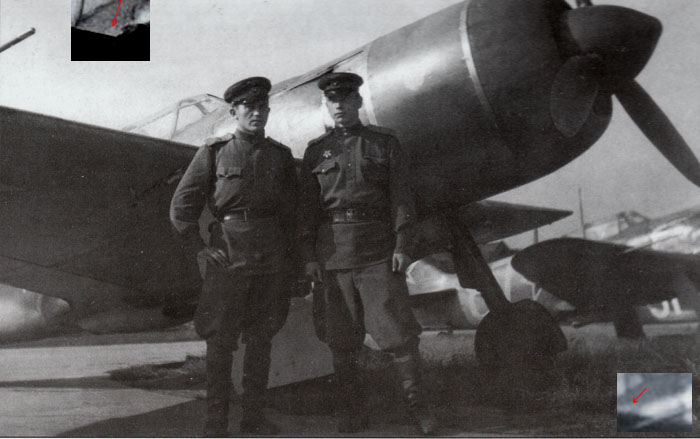
This photo shows a line of La-7s, presumably of 2 giap, taken in Prague-Kbely airport in May 1945.
The second plane is numbered 87; the third one, 31 or 51.
The first plane shows apparently red front ring and spinner, as expected.
The sides of the cowling are camouflaged with two greys; they seem glossy bacause freshly repainted, or perhaps they were made glossy to reduce drag.
On the side of the cowling, we can see the La-7 factory logo; because of this, it is possible that the plane never received the Guards emblem, at least on this side.
The rounded fonts of the numbers and the relatively small red stars suggest that the planes were built in Zavod 21.
Interestingly, one can vaguely see some light and blurried areas just where the inscription 'Mongolskiy arat' is documented on other planes. So, it is very likely that the photo shows planes and pilots of the 2nd squadron with the inscriptions.
Image from Lavockin La-7 of Milos Vestsik, MBI
'Georgievskiy Putyeyets' of Capt. Mayorov
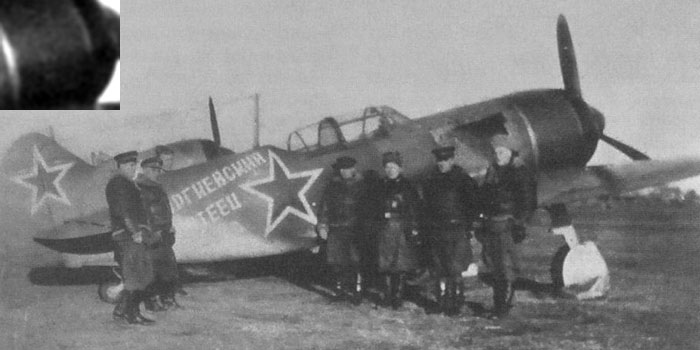
The La-7 assigned to Capt. A.I. Mayorov.
The text says 'Georgievskiy Putyeyets', that means 'Railman from Georgievsk', that raised the funds to pay the plane.
The size of the red stars seems typical of Zavod 381.
Note that both the nose ring and the nose sides appear dark; a vague circular halo suggests that a Guards emblem was deleted.
The plane on the background has a normally camouflaged cowling, probably it never received the emblem because it was delivered after the order to delete it.
The photo doesn't show the white oblique line on the tail that was seen on a photo of another plane of the unit, and is said to be the regimental marking of 2 giap; perhaps this line was adopted later.
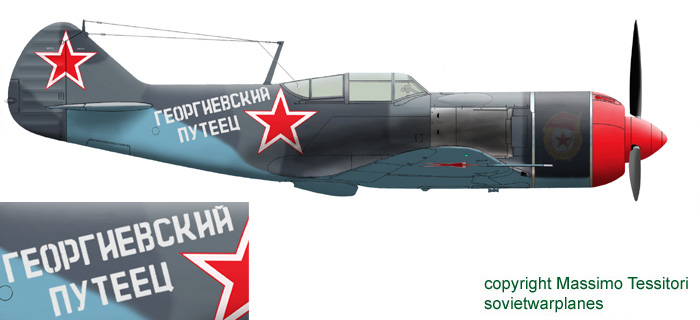
An interpretation of the plane of the photo above.
The dark side of the cowling could be dark grey AMT-12 freshly repainted to delete Guards emblems. The Guards emblem is vaguely visible through the repainting.
Unfortunately it isn't known if the slogan was on both sides, but it's likely so due to the use of a stencil.
It is likely that the plane received the white line on the tail after some time.
'Shilkinsky staratel' of Maj. Sobolyev
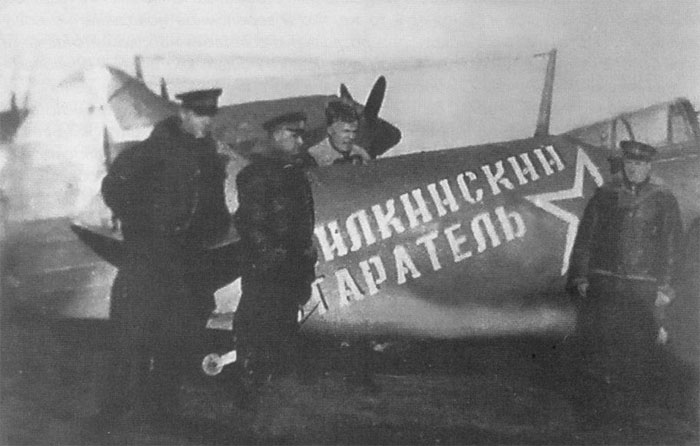
The commander of 2 giap, Maj. A.P. Sobolyev, received a plane gifted by the goldminers from the Shilka river, with the inscription "Shilkinsky staratel".
This photo is erroneously described as of a La.5FN on the source Aviacia i kosmonautika 2011-06.
Note that the bort numbers were deleted to make room for the inscription, that looks white with some black shadowing (only where overposed to the light blue of the undersurfaces).
Unfortunately it's not known if the inscription was on both sides, but the use of a stencil makes this likely.
The size of the stars suggest that the plane was built in Zavod 21.
http://aviadejavu.ru/Site/Crafts/Craft19957.htm
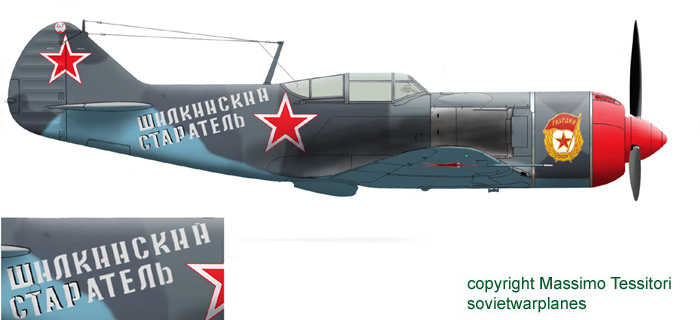
An interpretation of the plane above.
The nose, not visible on the photo, was hypothetically drawn as if/when it had the Guards emblem undeleted.
Unfortunately it isn't known if the slogan was on both sides, but it's likely so due to the use of a stencil.
